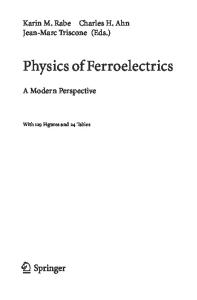Handbook of Modern Sensors Physics, Designs, and Applications
This book presents a comprehensive and up-to-date account of the theory (physical principles), design, and practical implementations of various sensors for scientific, industrial, and consumer applications. This latest edition focuses on the sensing techn
- PDF / 28,473,001 Bytes
- 765 Pages / 439.42 x 683.15 pts Page_size
- 812 Downloads / 4,814 Views
Handbook of Modern Sensors Physics, Designs, and Applications Fifth Edition
Handbook of Modern Sensors
Jacob Fraden
Handbook of Modern Sensors Physics, Designs, and Applications Fifth Edition
Jacob Fraden Fraden Corp. San Diego, CA, USA
ISBN 978-3-319-19302-1 ISBN 978-3-319-19303-8 DOI 10.1007/978-3-319-19303-8
(eBook)
Library of Congress Control Number: 2015947779 Springer Cham Heidelberg New York Dordrecht London # Springer International Publishing Switzerland 2004, 2010, 2016 # American Institute of Physics 1993, 1997 This work is subject to copyright. All rights are reserved by the Publisher, whether the whole or part of the material is concerned, specifically the rights of translation, reprinting, reuse of illustrations, recitation, broadcasting, reproduction on microfilms or in any other physical way, and transmission or information storage and retrieval, electronic adaptation, computer software, or by similar or dissimilar methodology now known or hereafter developed. The use of general descriptive names, registered names, trademarks, service marks, etc. in this publication does not imply, even in the absence of a specific statement, that such names are exempt from the relevant protective laws and regulations and therefore free for general use. The publisher, the authors and the editors are safe to assume that the advice and information in this book are believed to be true and accurate at the date of publication. Neither the publisher nor the authors or the editors give a warranty, express or implied, with respect to the material contained herein or for any errors or omissions that may have been made. Printed on acid-free paper Springer International Publishing AG Switzerland is part of Springer Science+Business Media (www.springer.com)
Preface
Numerous computerized appliances wash clothes, prepare coffee, play music, guard homes, and perform endless useful functions. However, no electronic device operates without receiving external information. Even if such information comes from another electronic device, somewhere in the chain, there is at least one component that perceives external input signals. This component is a sensor. Modern signal processors are the devices that manipulate binary codes generally represented by electric impulses. As we live in an analog world that mostly is not digital or electrical (apart from the atomic level), sensors are the interface devices between various physical values and the electronic circuits that “understand” only the language of moving electrical charges. In other words, sensors are eyes, ears, and noses of the silicon chips. This book is about the man-made sensors that are very much different from the sensing organs of living organisms. Since the publication of the previous edition of this book, sensing technologies have made remarkable leaps. Sensitivities of sensors have become higher, their dimensions smaller, selectivity better, and prices lower. A new, major field of application for sensors—mobile communication devices—has been rapidly evolving. Even t











